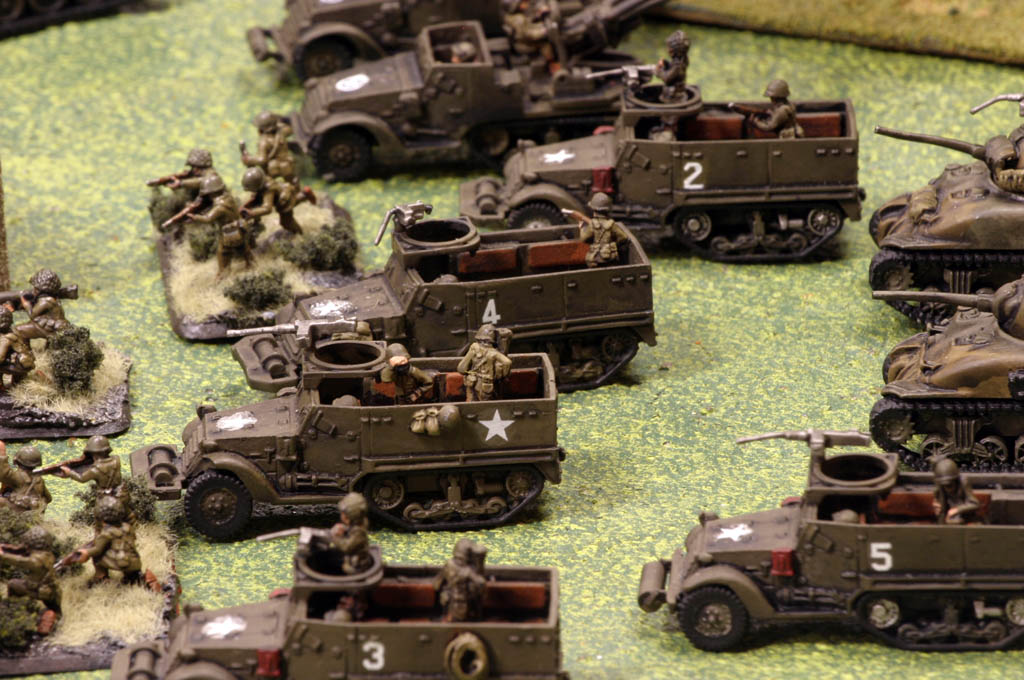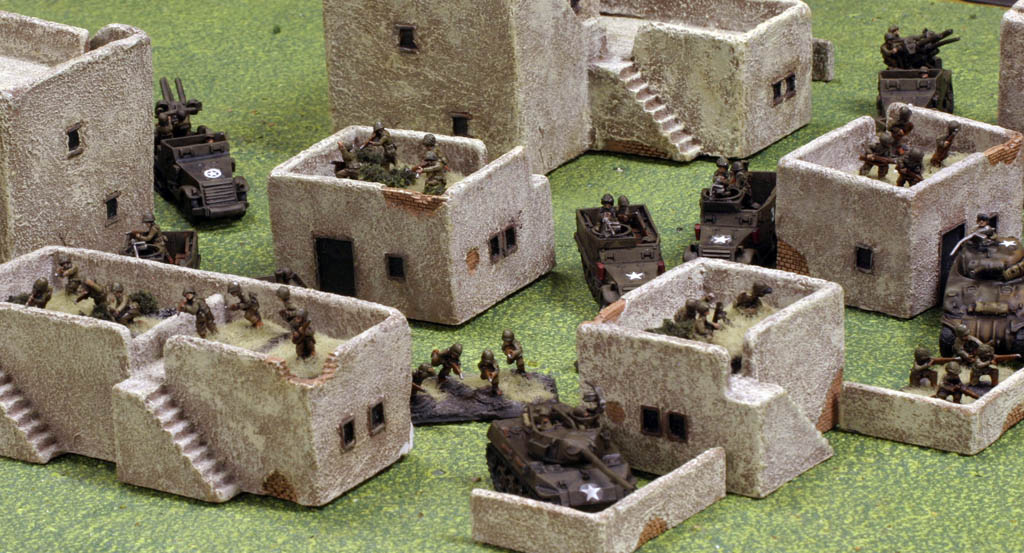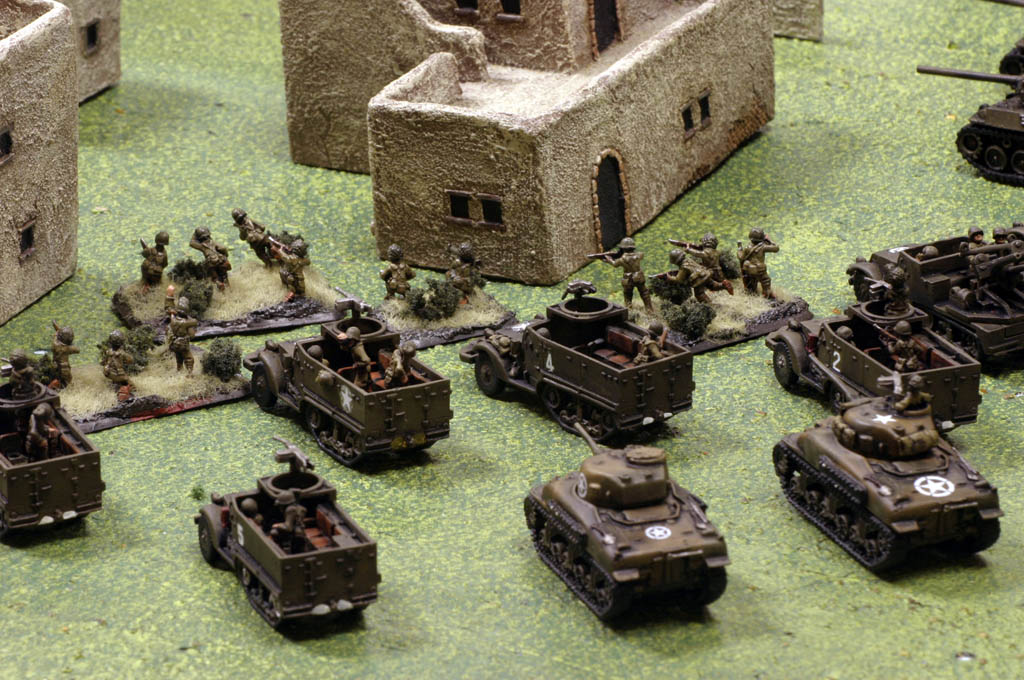FoW: Fielding A US Armored Rifle Company Part 1

Running an Armored Rifle, aka mechanized, company in Flames of War is a lot of fun, but demands a completely different play style than the more common infantry or tank forces. These are my experiences.
I started my Flames of War “career” with a mid-war American Rifle company. It was a large force that could field just about any support choices I could ever want in a 1500 or 1750 point game. Rifle companies tend to be pretty static in many missions; defending against most opponents. That’s fine for some, but it’s just not for me. I wanted more maneuver and mobility in my game play. The few tank platoons I could include in my rifle co. just weren’t enough! I’d admired the Armored Rifle force ever since I started playing FoW way back in 1st edition, but I’d put it off as being too expensive. I finally realized that I was better off slowly building up a force I’d really enjoy playing, than one that bored me to tears.
Armored Rifle forces have a fantastic mix of mobility and firepower, with good (but not the best) equipment. They really exemplify the combined arms style of warfare. A rifle company can win without tanks. A tank company can win without infantry. But a mechanized force has both. Awesome. The US is the only nation other than Germany to field halftrack mounted mechanized forces. Unlike their German counterparts, the US Armored Rifles are forced into taking fully mechanized support options. Yes, every mortar, artillery piece, and anti-tank gun will be fully motorized or mechanized. It’s completely historical and the mobility can be a real help at times, but it means you’ll be paying significantly more for some of your support options, especially if you are a Confident Veteran force. It also means you’ll end up owning a LOT of halftracks.
Tactically, playing an Armored Rifle force puts you into an interesting bind. If you use the Fortress Europe or North Africa rules, you’ll need to prepare to defend as often as you attack. Most tank companies will attack you, and you’ll be attacking most every rifle company. The Cobra book does have an “always attack” rule for AR forces selected from it, but it also lacks a couple support choices that I enjoy fielding, and I’ve actually found the “always attack” rule to be as much a hindrance as an advantage for an AR force.
Armored rifle forces are blessed with maybe the single best combat platoon in the game- the Armored Rifle platoon. For approximately 250 points you get a full confident trained platoon with 6 rifle teams (including the command team), 2 light machine guns (LMGs), a light mortar that can move and shoot, shoot over your own teams, and smoke, and 5 bazookas (or 4 bazookas and a 37mm gun). Oh, and you also get 5 halftrackss with passenger fired machine guns, two of which are .50cal MG’s. That gives you a platoon that can take on pretty much anything in the game with a reasonable chance of winning…….so long as you work the situation into your favor. See, most of these great weapons work best on the defensive, which is why I’m not completely sold on the “always attacking” Cobra lists. Bazookas have a negative to-hit modifier if they move and often can’t do much more than scratch the paint on a front armor shot against a heavy tank. The mortar can only fire once if it moves. LMG’s can’t fire at all! So to get the most out of your basic, core combat platoon, you really want to force the enemy to come to you. That’s easy when facing a tank company, or an “always attacks” force. In those cases, you start the game dismounted with your halftracks sent to the rear, and dig in on the objectives, forcing your armored opponent to weather a torrent of anti-tank and bazooka fire once they try to assault. However, it requires a lot more work when your ‘boys are on the attack.
Being the attacker requires a lot more finesse. Attacking a rifle company is hard. I find opposing veteran rifle companies to be my toughest match-up. Even veteran companies will often outnumber me, will have access to lots of low strength anti-tank shots that can turn my halftracks into mobile coffins (even heavy machine guns can do this!), and have enough high strength anti-tank fire to turn my supporting tanks into so much scrap metal. The fact that they’re often dug in in terrain on or near the objectives while I’m forced to cross the board to get them tends to result in them getting a lot more hits on me than I can get in on them due to the shooting modifier rules. Against this type of opponent, and against defending tank forces, your best bet is to use your mobility to create a refused flank, and attack with overwhelming force at one small part of your opponents’ line. If you need to dismount out of your halftracks and assault him off the objectives, try to dismount behind a nearby piece of LOS blocking terrain on his side of the board where you are close enough to move in and assault on the following turn.
If you can manage to take out his anti-tank fire, I find leaving your bazookas inside the halftracks can be invaluable. Why? Because it lets the halftracks continue firing those 3 shot machine guns, and when it comes to dislodging or pinning dug in infantry, the 3 shots from 1 halftrack MG is FAR more valuable than a 1 shot bazooka that will often hit on a 5 or 6. If you’ve destroyed his anti-tank support and have the turns, you should take even more advantage of those halftrack MG’s by sitting 14 or 15 inches away from his lines and pouring shots into his guys. Staying that far back keeps him in range of your MG’s and any recon troops, but outside of his assault range. Smoke is also a great option to help you make it into the assault, and can be invaluable against defending tank or machine gun platoons.
The next article will discuss list building, specifically what I’ve learned over the last year, and how your lists will change when fielding a trained versus veteran force. Have at it guys.







